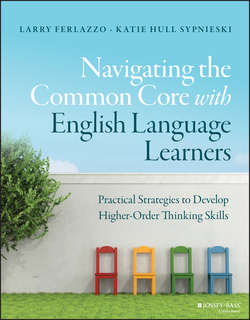Читать книгу Navigating the Common Core with English Language Learners - Sypnieski Katie - Страница 11
На сайте Литреса книга снята с продажи.
Chapter One
English Language Learners and the Common Core: An Overview
How Are English Language Learners Described?
ОглавлениеELLs are a diverse, dynamic group, which is evident in the large number of “labels” used to describe them. Here are some of the most common:
ELL, or English language learner: ELL (or EL) is the most current term used in the United States to describe students who are in various stages of acquiring English. The U.S. Department of Education defines an ELL (or EL) as:
An individual who, due to any of the reasons listed below, has sufficient difficulty speaking, reading, writing, or understanding the English language to be denied the opportunity to learn successfully in classrooms where the language of instruction is English or to participate fully in the larger U.S. society. Such an individual (1) was not born in the United States or has a native language other than English; (2) comes from environments where a language other than English is dominant; or (3) is an American Indian or Alaska Native and comes from environments where a language other than English has had a significant impact on the individual's level of English language proficiency.13
LEP, or limited English proficiency: LEP is still used by the U.S. Department of Education for ELLs, age 3–21, who have not yet demonstrated proficiency in English, and for whom this affects their ability to perform on state standards and assessments, to access classroom content, and/or to participate fully in society.14
DLL, or dual language learner: A child between the ages of 0 and 8 who is in the process of learning English in addition to his or her home language(s). These children may or may not also be considered ELLs by their schools, depending on their performance on English language proficiency assessments.15
ESL, or English as a second language: The term ESL was formerly used as a designation for ELL students, but is more commonly used now to refer to “a program of instruction designed to support ELL students” and is often still used at the postsecondary level to refer to multilingual students (National Council of Teachers of English,16 2008).
ELD, or English language development: ELD is often used to describe instruction and programs for ELL students that focus on developing English language proficiency in the domains of reading, writing, listening, and speaking.17
TESOL, or teaching English to speakers of other languages: TESOL is widely used to describe both TEFL (teaching English as a foreign language) and TESL (teaching English as a second language). In general, “TEFL emphasizes aspects of teaching English in countries where English is not widely used in daily life and the term TESL tends to emphasize the needs of learners who will use English in their daily lives, in addition to their mother-tongue. TESOL encompasses both.”18
Along with many educators and researchers, we prefer to use the term ELL because it emphasizes students as active learners of English, rather than as being limited or deficient in some way.
13
U.S. Department of Education, Institute of Education Sciences, & National Center for Education Statistics. (n.d.). The condition of education: Glossary. Retrieved from http://nces.ed.gov/programs/coe/glossary.asp
14
U.S. Department of Education. (n.d.). Title IX – General provisions. Retrieved from http://www2.ed.gov/policy/elsec/leg/esea02/pg107.html
15
Baird, A. S. (2015, May 11). Introducing the Dual Language Readers reader: Post #1. EdCentral. Retrieved from http://www.edcentral.org/dllreader1/#_ftn1
16
National Council of Teachers of English. (2008). English Language Learners. Retrieved from http://www.ncte.org/library/NCTEFiles/Resources/PolicyResearch/ELLResearchBrief.pdf
17
California Department of Education. (n.d.). Glossary of terms. Retrieved from http://www.cde.ca.gov/ds/sd/cb/glossary.asp#eld
18
Tesol Direct. (n.d.). What is TESOL? Retrieved from https://www.tesol-direct.com/definition-of-tesol
